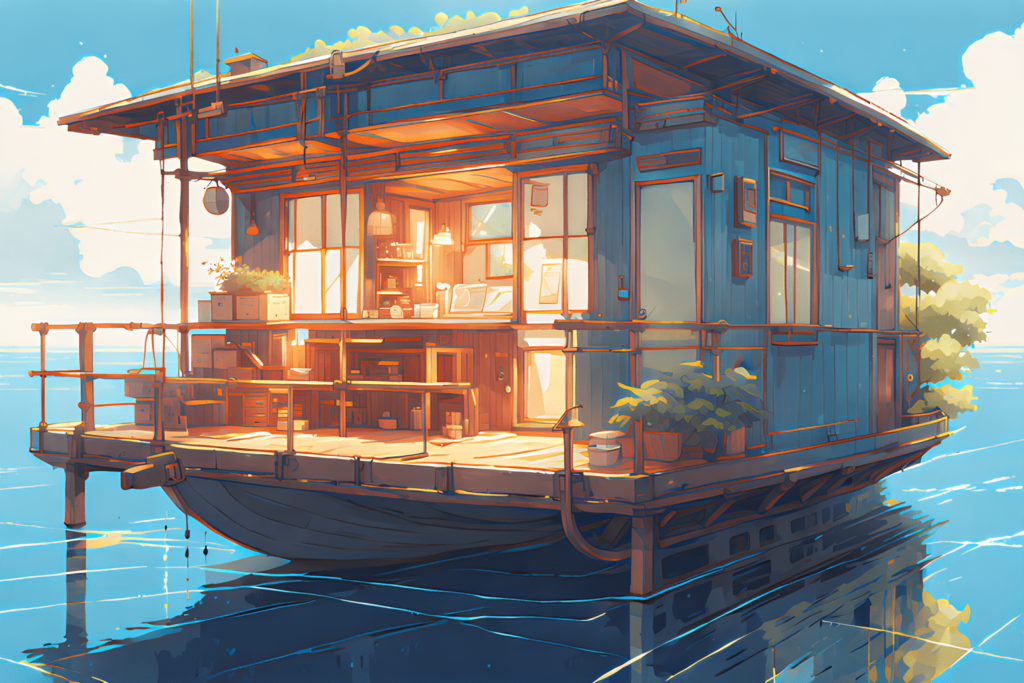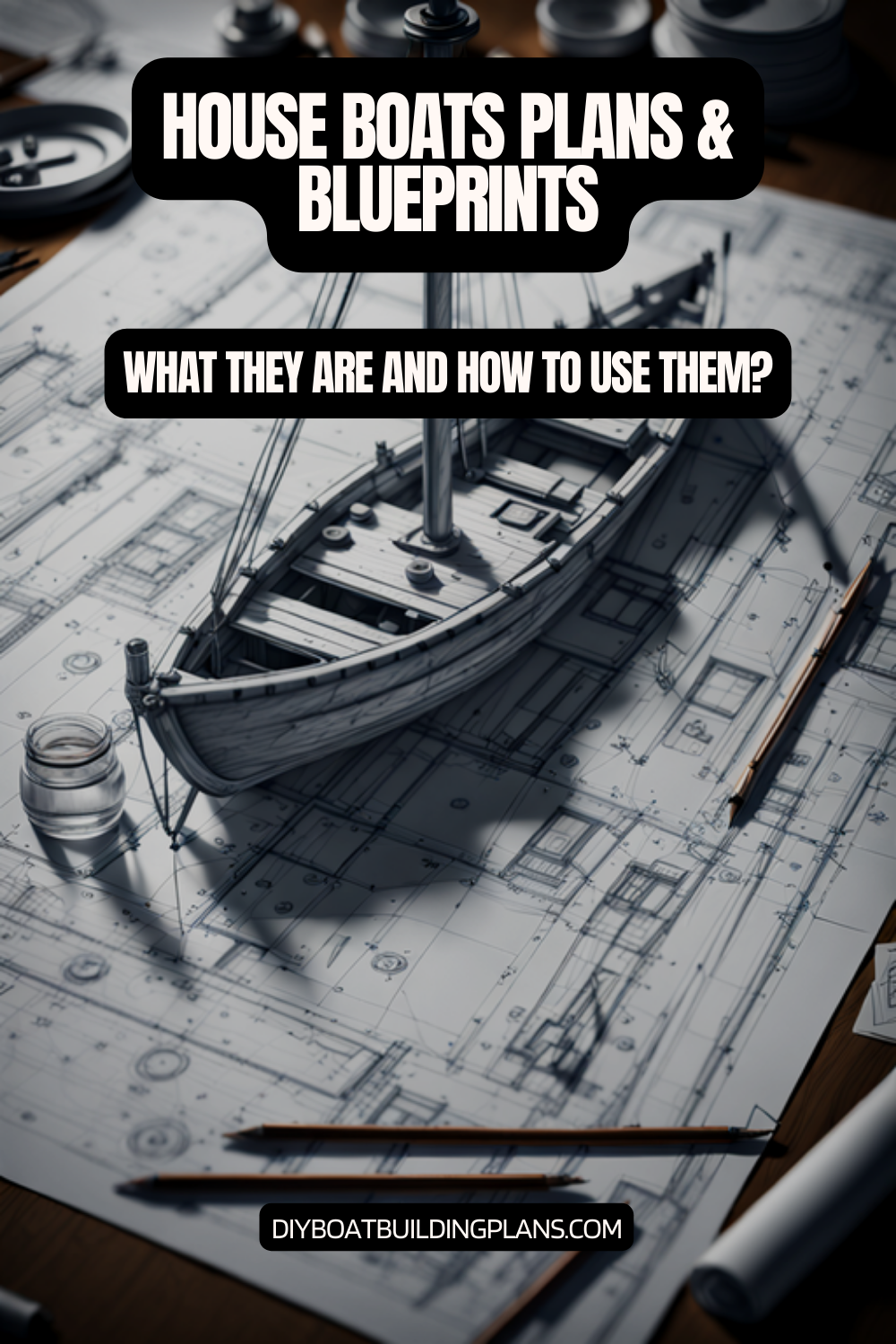Ever dreamed of having your own floating home? Building a DIY houseboat might seem hard, but many people are making it happen. They’re creating everything from small 16-foot homes to big 45-foot ones that change how we think about living.
DIY House Boat Plans & Blueprints are a great way for those who love adventure and building to make their dreams come true. There are more resources than ever for building your own houseboat. This lets you design and customize your dream floating home.
Today, you can choose from wood, fiberglass, aluminum, or steel for your houseboat. Modern guides offer detailed plans for all skill levels. Whether you’re experienced or just starting, these guides make building a houseboat easier to follow.
Key Takeaways – House Boat Plans & Blueprints
- DIY houseboat plans accommodate multiple skill levels
- Multiple material options enable customized construction
- Comprehensive blueprints simplify complex building processes
- Houseboat sizes range from 16 to 45 feet
- Growing community supports DIY maritime enthusiasts

Introduction to DIY House Boats
Ever dreamed of building your own floating home? DIY house boat projects let you turn Pontoon Boat House Plans into a unique aquatic home. It’s not just a project; it’s an adventure that mixes creativity, craftsmanship, and freedom.
Creating Shantyboat Building Schematics needs careful planning and marine construction knowledge. You can choose from small 16-foot boats to big 40-foot homes.
Benefits of Building Your Own House Boat
- Save thousands of dollars compared to professional construction
- Customize design to match personal preferences
- Learn valuable woodworking and marine engineering skills
- Create a unique living or recreational space
Overview of Required Materials
Good Aquatic Dwelling Blueprints need top-notch materials. Key items include:
| Material | Purpose | Recommended Type |
|---|---|---|
| Marine Plywood | Hull Construction | Premium Meranti Grade |
| Epoxy Resin | Waterproofing | Marine-Grade Epoxy |
| Structural Glue | Bonding Components | Titebond III |
Planning Your DIY Project
Getting ready is essential for a houseboat project. Think about the boat’s size, weight, and use. Sites like Bateau.com and Glen-L have detailed plans for all types of boats.
“A well-planned houseboat is more than a vessel—it’s a floating expression of personal creativity and engineering skill.”
Whether it’s a weekend getaway or a permanent home, building a DIY houseboat is rewarding. With research, patience, and focus, you can make your maritime dreams come true.
Choosing the Right Design for Your Needs
Finding the perfect houseboat design is all about careful thought. DIY fans looking into Liveaboard Boat House Designs have many choices. The right Custom Houseboat Plans can make your dream boat come true.
It’s important to know the different Houseboat DIY Kits out there. Each design has its own benefits, depending on what you need and like.
Types of House Boat Designs
Houseboat designs come in many shapes and sizes. Each has its own special features:
- Flat Hull Designs: Stable and spacious
- Rocker Hull Designs: Better for moving around
- Trailerable Models: Great for exploring different waters
- Multi-Level Configurations: Offers lots of room to live
Factors to Consider
| Design Factor | Importance |
|---|---|
| Sleeping Capacity | Very important for comfort |
| Interior Layout | Key to how well it works |
| Water Movement Capability | Affects how easy it is to move |
| Budget Constraints | Can guide your choices |
Customizing Your Blueprints
Personalizing your houseboat plans is essential. Think about adding skegs for better tracking or changing designs to fit your needs.
“The perfect houseboat design reflects your unique lifestyle and nautical dreams.”
There are over 500 boat plans to choose from, giving DIY fans lots of options. Websites like Glen-L Marine are great places to start for those building their own houseboat.
Unlock the secrets to building your dream boat with MyBoatPlans! With detailed plans for over 518 boats and expert video tutorials, you’ll have everything you need to create your perfect vessel. Click here to begin your journey!
Essential Tools for Your DIY House Boat
Building your own house boat needs careful planning and the right tools. You’ll need a mix of tools that are efficient, safe, and precise. This is key for your DIY House Boat Plans & Blueprints.
Hand Tools vs. Power Tools
Choosing the right tools is critical for a successful houseboat project. You’ll need both hand and power tools in your toolkit:
- Hand Tools:
- Measuring tape
- Carpenter’s level
- Hammer
- Chisels
- Handsaw
- Power Tools:
- Circular saw
- Drill
- Sander
- Nail gun
- Angle grinder
“The right tool can transform a challenging project into an enjoyable experience.” – Experienced DIY Boat Builder
Safety Equipment Recommendations
Always prioritize safety when working on your DIY House Boat Plans & Blueprints. Here are some must-have safety items:
- Safety glasses
- Work gloves
- Ear protection
- Dust masks
- Steel-toed boots
Tool Maintenance Tips
Keeping your tools in good condition is essential. Clean tools after each use, store them in a dry place, and check for wear and tear regularly. Use quality lubricants and protective cases to make your tools last longer.
| Tool Category | Maintenance Frequency | Key Actions |
|---|---|---|
| Hand Tools | After Each Use | Clean, dry, and oil metal parts |
| Power Tools | Monthly | Check electrical connections, lubricate moving parts |
| Safety Equipment | Before Each Use | Inspect for damage, replace worn components |
Step-by-Step Construction Process
Starting a DIY floating home project needs careful planning and execution. Guides for building a floating home suggest a step-by-step approach. This helps turn your dream into reality.
Creating a homemade houseboat starts with detailed preparation and smart construction methods. Each step requires precision and focus on important details.
Preparing the Hull
The hull is the base of your floating home. Choose materials that are durable and stable:
- Marine-grade plywood
- Fiberglass composites
- Lightweight aluminum
- Reinforced composite materials
“A solid hull is the backbone of any successful houseboat project.” – Maritime Engineering Expert
Building the Frame and Deck
Building a strong frame is key. Consider these important points:
- Ensuring proper weight distribution
- Creating enough headroom
- Designing for structural integrity
- Adding stabilization features
Adding Utilities and Interiors
Make your floating home livable by adding essential utilities:
- Electrical Systems: Dual 12V DC and 110V AC setups
- Plumbing: Install hot and cold water
- Living Spaces: Design an efficient layout
- Safety Features: Use marine-grade fire extinguishers and emergency gear
Your homemade houseboat design shows your creativity while following marine building rules. With careful work, your floating home becomes a unique place to live on the water.
Understanding Marine Regulations
When you dive into Pontoon Boat House Plans, knowing marine laws is key. Building a shantyboat is more than just building. It’s about following laws and keeping everyone safe.
Creating Shantyboat Building Schematics means looking at many rules. These rules can affect your project’s success and safety.
Necessary Permits and Permissions
Before you can use your houseboat, you must get certain permits. You’ll need:
- Local waterway usage permits
- State marine registration
- Environmental impact assessments
- Vessel safety certification
Safety Standards for House Boats
Marine safety rules are vital for your safety and others on the water. Important safety steps include:
- Checking if your boat can float properly
- Setting up electrical systems that meet standards
- Following US Coast Guard rules
- Having emergency communication tools
Environmental Considerations
Building a houseboat that’s good for the environment is important. Think about these green tips:
| Environmental Factor | Recommended Action |
|---|---|
| Water Pollution Prevention | Put in systems that handle waste well |
| Marine Ecosystem Protection | Choose materials and paints that are safe for the sea |
| Energy Efficiency | Add solar panels and other green energy options |
“Responsible boating starts with understanding and respecting marine regulations.” – Maritime Safety Expert
By planning well and following the rules, your Pontoon Boat House Plans can become a real, safe, and legal dream.
Budgeting for Your DIY House Boat
Starting a DIY house boat project needs good financial planning. Knowing the costs helps manage your budget and makes your dream come true.
Download over 500 Boat Plans. Click on the link below.
-->Click Here<--
Estimating Material Costs
Building a houseboat has many financial factors. A 50-foot houseboat can cost between $20,000 to $40,000 if you do it yourself. The main costs are:
- Hull and base materials
- Electrical components
- Plumbing systems
- Interior finishing
Comprehensive Cost Breakdown
| Component | Estimated Cost Range |
|---|---|
| Pontoon Base | $3,000 – $10,000 |
| Inboard Motor | $8,000 – $16,000 |
| Outboard Motor | $15,000 – $30,000 |
| Basic Materials | $5,000 – $15,000 |
Saving Tips for DIY Projects
Here are ways to save money:
- Buy affordable plan guides
- Find second-hand materials
- Use online community resources
- Learn skills for free
“Smart budgeting turns your houseboat dream into an achievable reality.”
Setting a Spending Limit
To set a realistic budget, do this:
- Determine your total funds
- Add a 20% buffer
- Keep track of your spending
- Focus on the most important parts
With good planning, your DIY house boat can be affordable and fun.
Tips for Successful DIY House Boat Projects
Starting a DIY houseboat project needs careful planning and hard work. Whether you’re using Houseboat DIY Kits or making Custom Houseboat Plans, success comes from avoiding common mistakes and staying focused.
Common Mistakes to Avoid
When building your dream floating home, watch out for a few big mistakes:
- Underestimating total project costs
- Neglecting proper marine-grade materials
- Skipping essential safety inspections
- Overlooking local waterway regulations
“Preparation is the key to successful DIY houseboat construction.” – Maritime Engineering Expert
Time Management Strategies
Good time management is key to your Houseboat DIY Kits project. Break your Custom Houseboat Plans into smaller steps:
- Create a detailed project timeline
- Set realistic milestone goals
- Buffer extra time for unexpected challenges
- Track progress weekly
Staying Motivated Throughout the Process
Keeping your enthusiasm up is vital during long DIY projects. Join online houseboat communities, share your progress with photos, and celebrate small wins. This will help keep you motivated.
Building a houseboat is more than a project—it’s an exciting journey to unique waterfront living.
Maintaining Your House Boat
Keeping a Waterborne Residence Layouts in top shape takes hard work and smart planning. Starting with DIY House Boat Plans & Blueprints is just the first step. Regular upkeep keeps your floating home safe, comfy, and working well for many years.
Good boat care includes key steps to protect your investment and keep it running smoothly.
Regular Maintenance Checklist
- Inspect hull for damage or wear every 6 months
- Check electrical systems quarterly
- Examine plumbing connections and seals
- Clean and treat exterior surfaces
- Lubricate moving mechanical parts
Seasonal Preparations
Each season brings its own upkeep needs for your Waterborne Residence Layouts. Winterizing your houseboat prevents costly damage from freezing temperatures.
- Drain water systems before winter
- Cover exterior surfaces
- Remove sensitive electronics
- Apply protective marine-grade sealants
“A well-maintained boat is a reliable companion on your aquatic journey.” – Maritime Maintenance Expert
Best Practices for Longevity
Following DIY House Boat Plans & Blueprints means you must care for your boat regularly. Focus on preventing problems to make your boat last longer and keep its value high.
- Use marine-grade materials for repairs
- Invest in quality protective coatings
- Schedule professional inspections annually
- Keep detailed maintenance records

Resources for Further Learning
Exploring homemade houseboat designs is a journey that never ends. This article is just the start. You’ll find many resources to help you learn more about building your own watercraft. These can range from small 10-foot boats to large 54-foot cruisers.
Online communities and forums are great for learning. Websites like Wooden Boat Magazine and Boating World have lots of information for DIY fans. You can also take hands-on workshops at places like Northwest School of Wooden Boatbuilding.
There are many books to read, like “Build Your Own Boat” by Greg Rossel and “Boat Building with Plywood” by Glen L. Witt. They cover building different boats, from simple designs to complex ones. Online courses and digital platforms can also help you improve your skills.
Boat building is a lifelong learning process. Keep up with expert communities, go to workshops, and always learn more. This way, you can build safe, efficient, and beautiful houseboats that meet your needs.
FAQ – House Boat Plans & Blueprints
How long does a typical DIY houseboat take to build?
The time it takes to build a DIY houseboat varies. It depends on your skill level, how much time you have, and the design’s complexity. An experienced DIYer might take 3-6 months, while a beginner could need up to a year.
What is the average cost of building a DIY houseboat?
The cost can range from $5,000 to $25,000. This depends on the size, materials, and how customized it is. A 25-foot plywood houseboat usually costs between $10,000-$15,000 for materials and basic needs.
Do I need special skills to build a houseboat?
You don’t need to be a pro carpenter or woodworker. Many DIYers learn as they go. What’s more important is patience, a willingness to learn, and following plans carefully.
What are the most important safety considerations when building a houseboat?
Safety first! Make sure it floats right, use marine-grade materials, and install good electrical systems. A stable hull design and following local marine laws are also key. Always focus on making it strong and use safety gear while building.
Can I trailer my DIY houseboat?
Yes, many designs can be towed. A typical trailerable houseboat is 26′ long, 8’4″ wide, with a 4″ draft and weighs about 3,750 lbs. But, check local laws and make sure your vehicle can handle the weight.
What materials are best for building a houseboat?
Plywood is the go-to for hulls, and it should be marine-grade. Use Titebond III glue for waterproof bonding. You’ll also need flotation foam, marine-grade fiberglass, and fasteners that won’t rust.
Do I need special permits to build a houseboat?
Permits vary by location. You’ll need to check with local marine authorities, county rules, and possibly state transportation departments. Some places require safety certifications and inspections for homemade boats.
What tools will I need to build a houseboat?
You’ll need a circular saw, drill, sander, measuring tape, level, clamps, and safety gear. Power tools can help, but many builders use a mix of hand and power tools. Always keep your tools safe and well-maintained.
How do I choose the right houseboat design?
Think about how you’ll use it, the water type, how many will sleep there, and your building skills. Designs range from 16′ to 45′ long, with flat or rocker hulls. Free plans like Lisa B. Good or Glen-L’s Huck Finn are good starting points.
What ongoing maintenance does a houseboat require?
Regular upkeep includes checking the hull, maintaining electrical and plumbing, treating wood, checking foam, and prepping for seasons. Annual checks and quick repairs are key for safety and longevity.



